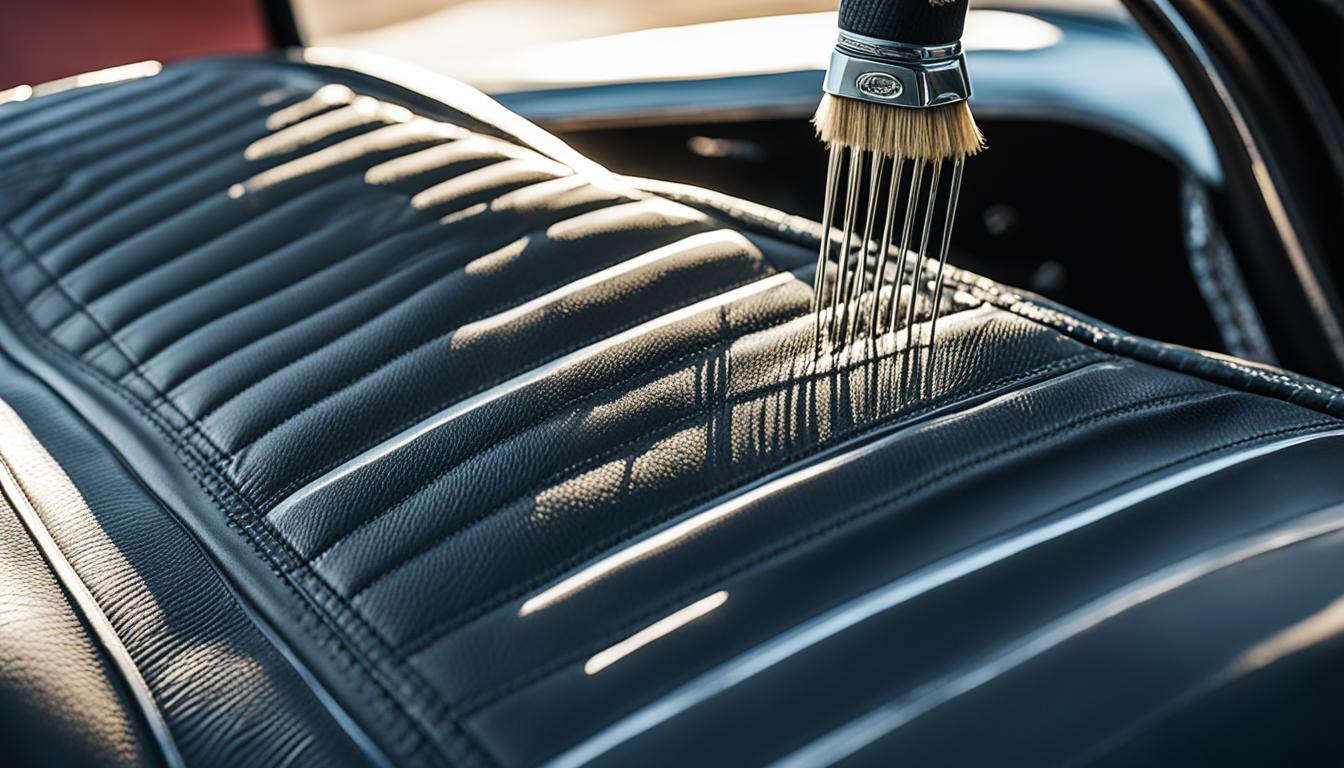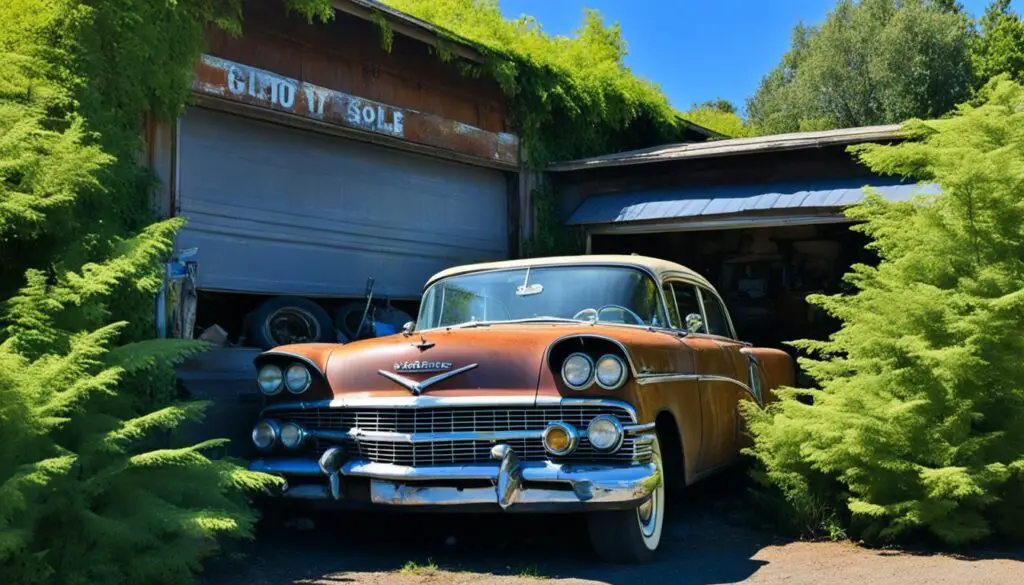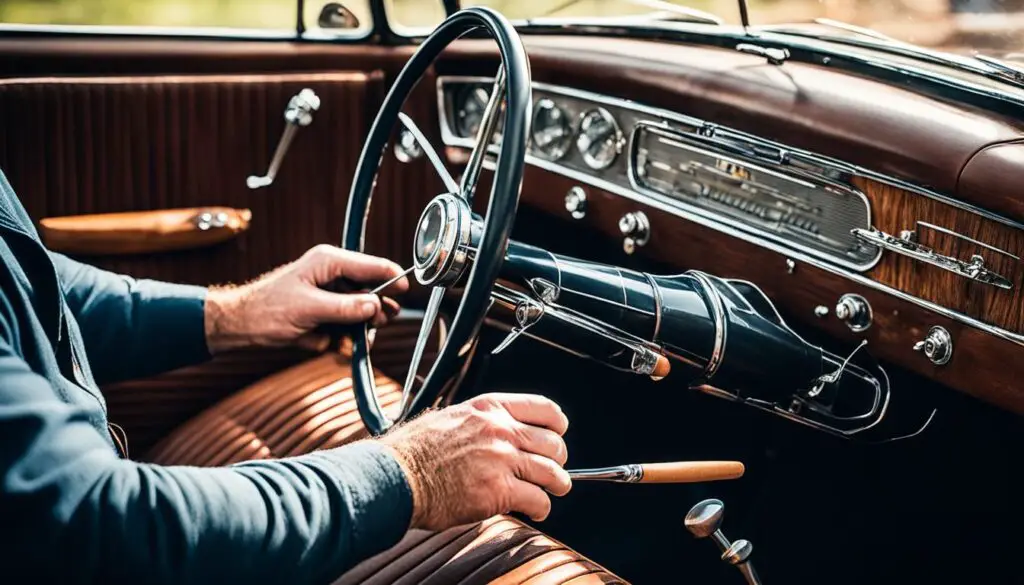
Step Back in Time: Classic Car Interior Restoration Tips
Hello, fellow vintage car enthusiasts! Owning and driving a classic car brings a unique joy. It’s not just a car; it’s a piece of history with timeless charm. To truly feel like you’re in another era, the car’s interior matters just as much as the exterior.
Restoring a classic car’s interior is rewarding but challenging. It brings the car’s inside back to its original allure. This not only makes driving better but also boosts the car’s value. Whether you’re new to classic cars or a seasoned collector, these tips on interior restoration will be invaluable.
Key Takeaways:
- Classic car interior restoration is about restoring the interior of a vintage car to its original glory.
- The interior of a classic car is just as important as its exterior and enhances the driving experience.
- Clear goals, budgeting, and the right materials are crucial for a successful restoration.
- Pay attention to seats, dashboard, door panels, flooring, ceiling, and windows.
- Enjoy the labor of love that is classic car interior restoration and experience the timeless elegance of automotive history.
How to Buy a Classic Car for Restoration
Do you dream of restoring a classic car? The first step is to pick out the perfect old vehicle. You’ll need some key advice to make a smart purchase for your project.
- Decide on the make and model: Start by choosing the type of classic car you’d like to overhaul. It could be something famous like a Ford Mustang or unique like a vintage Volkswagen Beetle. Setting your sights on a specific model will help narrow down your search.
- Research and compare prices: Shop around to get an idea of what’s out there and how much it costs. This comparison ensures you’re not overpaying and might help you score a better deal.
- Have the car appraised: Getting a professional appraisal before you purchase is wise. It’ll tell you the car’s current state and what it might be worth after being restored. Knowing this info helps you make a smart decision that fits your budget and goals.
- Consider the overall investment: Think about all the costs involved, not just the purchase price. Restoration needs like new parts and labor can add up. Look closely at the engine and transmission too, as fixing these can be costly.
- Familiarize yourself with local laws: Buying and fixing up an old car comes with legalities that vary by state. Make sure to check the rules in your area for a hassle-free project.
Buying a classic car to restore is both an investment and a chance to follow your heart. Choose one that really speaks to you. Then, get ready for a rewarding journey reviving a piece of automotive history.

Comparison Table: Popular Classic Car Makes and Models for Restoration
| Make | Model | Years | Average Price Range |
|---|---|---|---|
| Ford | Mustang | 1965-1973 | $20,000 – $50,000 |
| Chevrolet | Camaro | 1967-1969 | $25,000 – $60,000 |
| Mercedes-Benz | SL-Class | 1963-1971 | $15,000 – $80,000 |
| Volkswagen | Beetle | 1950-1979 | $5,000 – $30,000 |
| Jeep | Wrangler | 1945-1986 | $10,000 – $40,000 |
Planning and Budgeting for Classic Car Interior Restoration
Proper planning and budgeting are key for a successful classic car interior restoration. Setting clear goals and creating a solid plan helps the process run smoothly. From start to finish, you’ll be on the right track.
Prioritize Tasks and Materials
First, look at your classic car’s interior condition. Figure out what needs repair or replacement. This step helps you decide what to focus on and how much to spend. Think about what will make the biggest difference in looks and function.
After that, find the right materials for your project. Look for high-quality, era-appropriate materials. Whether it’s choosing the perfect seat fabric or matching trim pieces, the little things matter. Paying attention to detail is key for a great outcome.
Set a Realistic Budget
It’s vital to figure out your restoration project’s budget. This includes material costs, potential professional help, and your time. Set a realistic budget. Restoring a classic car takes a lot of work and time.
Research and Gather Tools
Before you start, make sure you have the tools and equipment you need. The right tools make your work more efficient and accurate. A well-prepared toolbox is essential for success.
Consider Professional Detailing Services
If you have the budget and want top-quality results, think about hiring detail specialists. They know how to bring classic car interiors back to life. Professional detailing can give your car a like-new look.
Finally, remember that restoring a classic car’s interior is a passion project. Take your time and savor each step. It’s not just about making your car look great. It’s about keeping automotive history alive for generations to come.

| Tasks | Materials |
|---|---|
| Remove old upholstery | Period-accurate fabric |
| Repair dashboard | Trim restoration kit |
| Refinish door panels | Interior paint |
| Replace flooring | Correct carpeting |
| Restore ceiling | Headliner material |
| Repair windows | Window seals and glass |
Conclusion
Restoring a classic car’s inside is rewarding. You get to bring an old car back to its former glory. This process requires hard work and close attention. Yet, the outcome makes it all worth it.
To restore a classic car’s interior, use the right methods and materials. You can fix everything, from the seats to the dash and doors. All these parts can look brand new again.
Fixing the inside not only makes driving better. It also makes the car worth more money. A classic car with a beautiful inside is a treasure for any collector.
You can do it yourself or get help from experts. Either way, bringing a classic car back to life is a great opportunity. You honor the beauty and history of classic cars this way. It’s a project that shows your love for cars.
FAQ
What is classic car interior restoration?
Restoring a classic car’s inside makes it look like new. This process fixes or changes inside parts. It makes the car’s interior shiny and new again.
Why is the interior of a classic car important?
A classic car’s inside is key. It boosts the driving feel and adds to the car’s worth. A done-up interior transforms a good classic into a great one.
What aspects of the interior should I focus on when restoring a classic car?
Seats, the dashboard, and door panels are vital. Don’t forget about the flooring, ceiling, and windows. Each part’s restoration is important for a complete look.
How do I choose the right classic car for restoration?
Pick a car brand and model you like for restoration. Look for best prices and check the car’s value. Get advice from an expert to know the restoration work needed.
What should I consider before purchasing a classic car for restoration?
Think about the total cost, including restoration and repairs. Check the car’s working parts and your state’s car laws. This helps in wise decision and enjoyable restoration.
How should I plan and budget for a classic car interior restoration?
Plan each step and decide what to fix first. Set a budget considering materials and your time. Use authentic materials to keep the car’s original style.
Should I consider professional assistance for the restoration?
Deciding between DIY and professional help is up to you. Both paths are rewarding. For a fine finish, consider expert detailing.
What tools do I need for the restoration process?
Find and collect the tools you need like screwdrivers and sandpaper. Having all necessary tools will simplify the restoration work.
How do I document the restoration process?
Take photos at every restoration step. They’re not just records but will help in future work and share the project with others.
What are the benefits of classic car interior restoration?
Restoring a classic car inside is deeply satisfying. It revives a vintage beauty, honors its history, and shows your love for these treasures.
Source Links
- https://shop.advanceautoparts.com/r/car-culture/classic-cars/how-to-restore-a-classic-cars-interior
- https://www.legendaryautointeriors.com/blogs/blog/best-practices-for-classic-auto-interior-restoration
- https://www.classiccarsofsarasota.com/blog/how-to-bring-your-car-back-to-life-with-classic-car-interior-restoration
